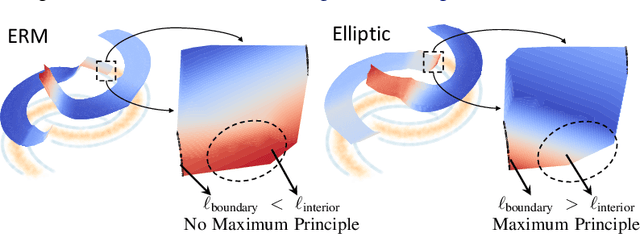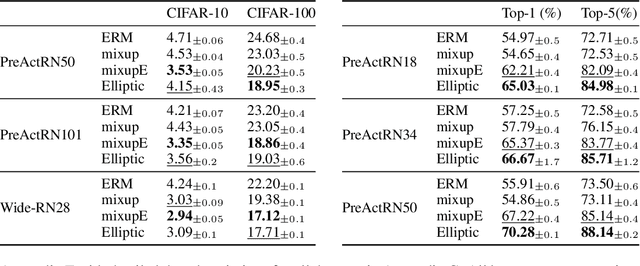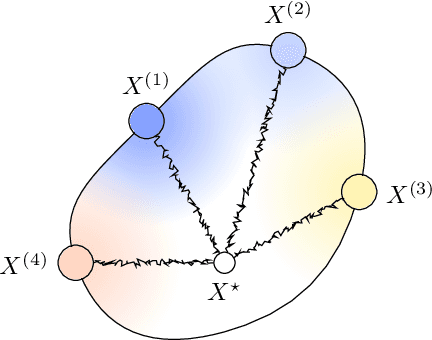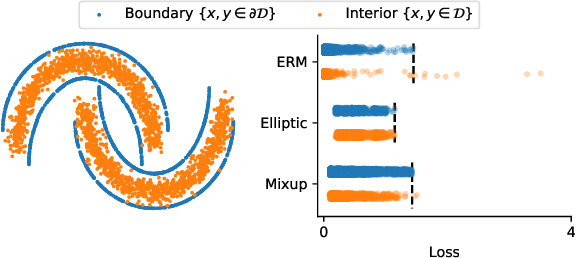Vahid Tarokh
Duke University
PASTA: A Unified Framework for Offline Assortment Learning
Oct 02, 2025Abstract:We study a broad class of assortment optimization problems in an offline and data-driven setting. In such problems, a firm lacks prior knowledge of the underlying choice model, and aims to determine an optimal assortment based on historical customer choice data. The combinatorial nature of assortment optimization often results in insufficient data coverage, posing a significant challenge in designing provably effective solutions. To address this, we introduce a novel Pessimistic Assortment Optimization (PASTA) framework that leverages the principle of pessimism to achieve optimal expected revenue under general choice models. Notably, PASTA requires only that the offline data distribution contains an optimal assortment, rather than providing the full coverage of all feasible assortments. Theoretically, we establish the first finite-sample regret bounds for offline assortment optimization across several widely used choice models, including the multinomial logit and nested logit models. Additionally, we derive a minimax regret lower bound, proving that PASTA is minimax optimal in terms of sample and model complexity. Numerical experiments further demonstrate that our method outperforms existing baseline approaches.
Dual-Function Radar-Communication Beamforming with Outage Probability Metric
Aug 06, 2025Abstract:The integrated design of communication and sensing may offer a potential solution to address spectrum congestion. In this work, we develop a beamforming method for a dual-function radar-communication system, where the transmit signal is used for both radar surveillance and communication with multiple downlink users, despite imperfect channel state information (CSI). We focus on two scenarios of interest: radar-centric and communication-centric. In the radar-centric scenario, the primary goal is to optimize radar performance while attaining acceptable communication performance. To this end, we minimize a weighted sum of the mean-squared error in achieving a desired beampattern and a mean-squared cross correlation of the radar returns from directions of interest (DOI). We also seek to ensure that the probability of outage for the communication users remains below a desired threshold. In the communication-centric scenario, our main objective is to minimize the maximum probability of outage among the communication users while keeping the aforementioned radar metrics below a desired threshold. Both optimization problems are stochastic and untractable. We first take advantage of central limit theorem to obtain deterministic non-convex problems and then consider relaxations of these problems in the form of semidefinite programs with rank-1 constraints. We provide numerical experiments demonstrating the effectiveness of the proposed designs.
Conditional Average Treatment Effect Estimation Under Hidden Confounders
Jun 14, 2025Abstract:One of the major challenges in estimating conditional potential outcomes and conditional average treatment effects (CATE) is the presence of hidden confounders. Since testing for hidden confounders cannot be accomplished only with observational data, conditional unconfoundedness is commonly assumed in the literature of CATE estimation. Nevertheless, under this assumption, CATE estimation can be significantly biased due to the effects of unobserved confounders. In this work, we consider the case where in addition to a potentially large observational dataset, a small dataset from a randomized controlled trial (RCT) is available. Notably, we make no assumptions on the existence of any covariate information for the RCT dataset, we only require the outcomes to be observed. We propose a CATE estimation method based on a pseudo-confounder generator and a CATE model that aligns the learned potential outcomes from the observational data with those observed from the RCT. Our method is applicable to many practical scenarios of interest, particularly those where privacy is a concern (e.g., medical applications). Extensive numerical experiments are provided demonstrating the effectiveness of our approach for both synthetic and real-world datasets.
Elliptic Loss Regularization
Mar 04, 2025



Abstract:Regularizing neural networks is important for anticipating model behavior in regions of the data space that are not well represented. In this work, we propose a regularization technique for enforcing a level of smoothness in the mapping between the data input space and the loss value. We specify the level of regularity by requiring that the loss of the network satisfies an elliptic operator over the data domain. To do this, we modify the usual empirical risk minimization objective such that we instead minimize a new objective that satisfies an elliptic operator over points within the domain. This allows us to use existing theory on elliptic operators to anticipate the behavior of the error for points outside the training set. We propose a tractable computational method that approximates the behavior of the elliptic operator while being computationally efficient. Finally, we analyze the properties of the proposed regularization to understand the performance on common problems of distribution shift and group imbalance. Numerical experiments confirm the utility of the proposed regularization technique.
Parabolic Continual Learning
Mar 03, 2025



Abstract:Regularizing continual learning techniques is important for anticipating algorithmic behavior under new realizations of data. We introduce a new approach to continual learning by imposing the properties of a parabolic partial differential equation (PDE) to regularize the expected behavior of the loss over time. This class of parabolic PDEs has a number of favorable properties that allow us to analyze the error incurred through forgetting and the error induced through generalization. Specifically, we do this through imposing boundary conditions where the boundary is given by a memory buffer. By using the memory buffer as a boundary, we can enforce long term dependencies by bounding the expected error by the boundary loss. Finally, we illustrate the empirical performance of the method on a series of continual learning tasks.
S2TX: Cross-Attention Multi-Scale State-Space Transformer for Time Series Forecasting
Feb 17, 2025Abstract:Time series forecasting has recently achieved significant progress with multi-scale models to address the heterogeneity between long and short range patterns. Despite their state-of-the-art performance, we identify two potential areas for improvement. First, the variates of the multivariate time series are processed independently. Moreover, the multi-scale (long and short range) representations are learned separately by two independent models without communication. In light of these concerns, we propose State Space Transformer with cross-attention (S2TX). S2TX employs a cross-attention mechanism to integrate a Mamba model for extracting long-range cross-variate context and a Transformer model with local window attention to capture short-range representations. By cross-attending to the global context, the Transformer model further facilitates variate-level interactions as well as local/global communications. Comprehensive experiments on seven classic long-short range time-series forecasting benchmark datasets demonstrate that S2TX can achieve highly robust SOTA results while maintaining a low memory footprint.
Teleportation With Null Space Gradient Projection for Optimization Acceleration
Feb 17, 2025Abstract:Optimization techniques have become increasingly critical due to the ever-growing model complexity and data scale. In particular, teleportation has emerged as a promising approach, which accelerates convergence of gradient descent-based methods by navigating within the loss invariant level set to identify parameters with advantageous geometric properties. Existing teleportation algorithms have primarily demonstrated their effectiveness in optimizing Multi-Layer Perceptrons (MLPs), but their extension to more advanced architectures, such as Convolutional Neural Networks (CNNs) and Transformers, remains challenging. Moreover, they often impose significant computational demands, limiting their applicability to complex architectures. To this end, we introduce an algorithm that projects the gradient of the teleportation objective function onto the input null space, effectively preserving the teleportation within the loss invariant level set and reducing computational cost. Our approach is readily generalizable from MLPs to CNNs, transformers, and potentially other advanced architectures. We validate the effectiveness of our algorithm across various benchmark datasets and optimizers, demonstrating its broad applicability.
Score-Based Metropolis-Hastings Algorithms
Dec 31, 2024



Abstract:In this paper, we introduce a new approach for integrating score-based models with the Metropolis-Hastings algorithm. While traditional score-based diffusion models excel in accurately learning the score function from data points, they lack an energy function, making the Metropolis-Hastings adjustment step inaccessible. Consequently, the unadjusted Langevin algorithm is often used for sampling using estimated score functions. The lack of an energy function then prevents the application of the Metropolis-adjusted Langevin algorithm and other Metropolis-Hastings methods, limiting the wealth of other algorithms developed that use acceptance functions. We address this limitation by introducing a new loss function based on the \emph{detailed balance condition}, allowing the estimation of the Metropolis-Hastings acceptance probabilities given a learned score function. We demonstrate the effectiveness of the proposed method for various scenarios, including sampling from heavy-tail distributions.
Learn2Mix: Training Neural Networks Using Adaptive Data Integration
Dec 21, 2024Abstract:Accelerating model convergence in resource-constrained environments is essential for fast and efficient neural network training. This work presents learn2mix, a new training strategy that adaptively adjusts class proportions within batches, focusing on classes with higher error rates. Unlike classical training methods that use static class proportions, learn2mix continually adapts class proportions during training, leading to faster convergence. Empirical evaluations on benchmark datasets show that neural networks trained with learn2mix converge faster than those trained with classical approaches, achieving improved results for classification, regression, and reconstruction tasks under limited training resources and with imbalanced classes. Our empirical findings are supported by theoretical analysis.
Offline Stochastic Optimization of Black-Box Objective Functions
Dec 03, 2024



Abstract:Many challenges in science and engineering, such as drug discovery and communication network design, involve optimizing complex and expensive black-box functions across vast search spaces. Thus, it is essential to leverage existing data to avoid costly active queries of these black-box functions. To this end, while Offline Black-Box Optimization (BBO) is effective for deterministic problems, it may fall short in capturing the stochasticity of real-world scenarios. To address this, we introduce Stochastic Offline BBO (SOBBO), which tackles both black-box objectives and uncontrolled uncertainties. We propose two solutions: for large-data regimes, a differentiable surrogate allows for gradient-based optimization, while for scarce-data regimes, we directly estimate gradients under conservative field constraints, improving robustness, convergence, and data efficiency. Numerical experiments demonstrate the effectiveness of our approach on both synthetic and real-world tasks.
 Add to Chrome
Add to Chrome Add to Firefox
Add to Firefox Add to Edge
Add to Edge